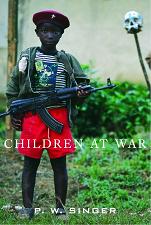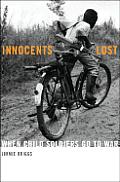BOOKS : Poignant tragedy of child soldiers
BY KIM KNAPP SAWYER Special to the Post-Dispatch.
Aug 31, 2005 — “I heard that the rebels at least were eating. So I joined them.” These are the words of a Congolese child soldier — one of 300,000 children around the world who are child combatants.

But “Children at War” is not a book about numbers. It is the tragic story of a violent world and the desperate choices people are forced to make; it is an illuminating study of policy and the choices that face the international community.
Singer, a National Security Fellow at the Brookings Institution as well as the director of the Brookings Project on U.S. Policy Towards the Islamic World, begins his book with a brief overview and then provides a careful and thorough study of child soldiers. He discusses the recruitment and experiences of child soldiers on the battlefield, as well as the governments and rebel groups that condone and promote their use. He concludes with an analysis of the ways in which the international community responds.
Children lacking basic necessities and educational opportunities, many of them orphans, turn to the military for food, clothing, and medical attention. Most are looking for acceptance in a group and turn to their leader as a father figure, seeking in him the approval they crave. With no sense of their own mortality, they do not question the risks they take; nor do they think twice about what the future may hold. Children are often given alcohol or drugs (cocaine, barbiturates, amphetamines) to help make them fearless. With the cost of an AK-47 the same as a chicken (in countries like Uganda and Sudan), arming child soldiers becomes all too easy.
Singer outlines the roles played by the Coalition to Stop the Use of Child Soldiers, the United Nations, and non-governmental organizations, as well as various conventions and treaties, in preventing children from becoming soldiers. He underscores the need to “turn outrage into action” and to make the use of children as a weapon of war “simply unacceptable to the entire world.” He talks about dilemmas that face adult soldiers: In the words of a UN peacekeeper, “Do you shoot a child that looks like your son, even if it looks like they are going to shoot you?” Also mentioned is the possible development of non-lethal weapons, such as microwave beams, acoustic weapons, neural inhibitors, and calmative agents, to be used on child combatants.

In Rwanda, Briggs met Francois, a child soldier who, at age 16, was forced to kill his four nephews, and Duilio, a 15-year-old from Colombia who suffered brain damage after a landmine exploded in his face. Then there was Gueso, also from Colombia, who became “like a pet, like a son” to his commander. He had become inured to death, saying “You can’t think about the future here, because the future is a coffin.”
We learn that Tamil Tigers, the rebel girls in Sri Lanka, are “among the toughest, most committed warriors in the world.” Before engaging in suicide bombing missions, they are given cyanide capsules to wear on a string around their necks. If captured, they must swallow the poison.
Briggs spent six years traveling through war-torn countries. In a book filled with clear, vivid, and moving accounts, one that stands out involves a trip to northern Uganda where he meets Sister Rachele Fassera from St. Mary’s School, where 139 girls were abducted by the Lord’s Resistance Army in 1996.
Sister Rachele persuaded the commander to return the majority of the girls, but then was given the responsibility of choosing 30 girls who would have to remain behind to fight.
She would never be the same.
— –
“Children at War” By P.W. Singer
Published by Pantheon Books, 269 pages, $25
“Innocents Lost: When Child Soldiers Go to War” By Jimmie Briggs Published by Basic Books, 188 pages, $24.95
